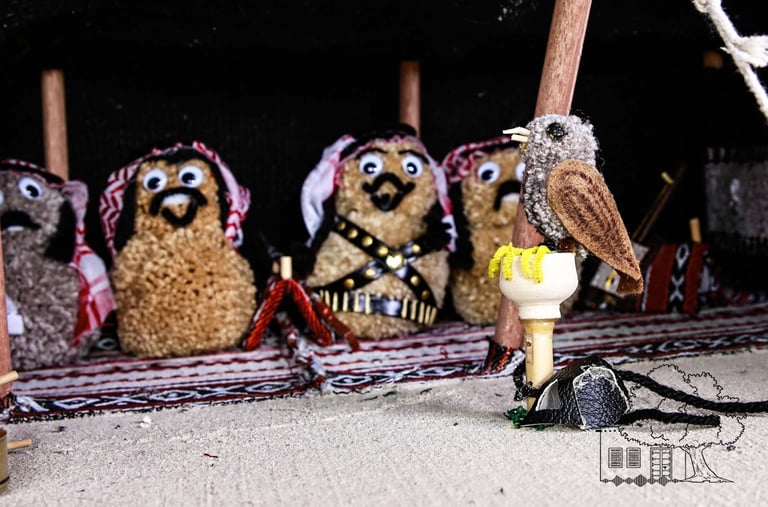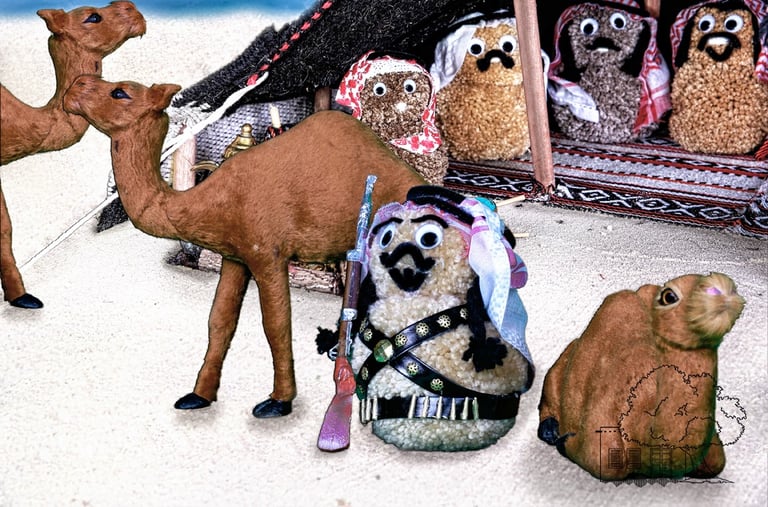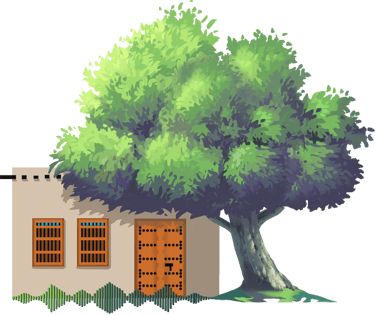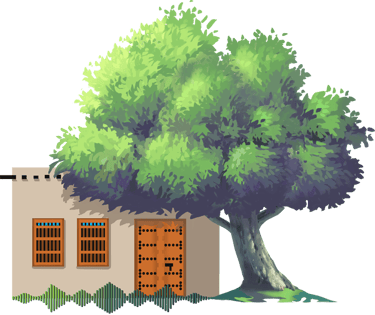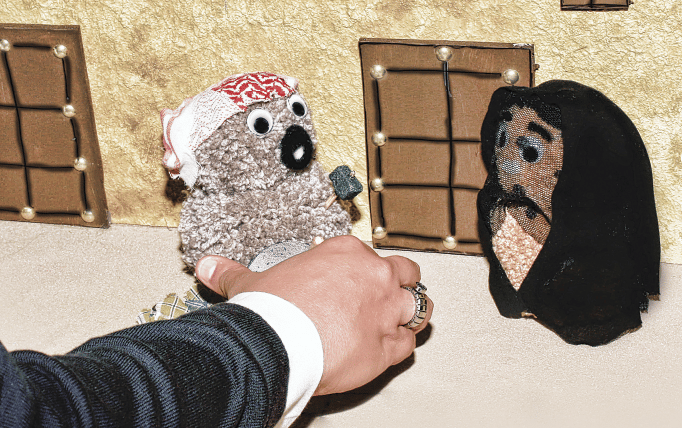Bedouin Life and the Bedouin Hair House
Hair houses are among the most important tools Bedouins have built for themselves using technical and traditional methods. Hair houses are also distinguished by their resistance and ability to withstand the changing conditions of the desert environment. Hair houses are light and easy to transport and maintain, and Bedouin women can repair hair houses without the need for assistance. The cover of the hair house is made of sadu, which has small openings that allow air to pass through. In the summer, the hair strands swell and their loops constrict due to water. This prevents water from seeping into the hair house. Furthermore, when a fire is lit inside the hair house, the smoke rises through the openings in its ceiling.
Hair houses have partitions that divide them into two or more parts. The partition is called a qat'. The hair house is rectangular in shape, open along one side (the front) and closed along the opposite side (the back). The back is only opened when necessary, such as when the wind direction changes or when seeking shade during intense heat.
The preferred woven house is one made of goat hair. If goat hair is unavailable, sheep wool or camel hair can be used.
This is because sheep wool or camel hair absorbs rainwater, causing it to drip and weigh more, making it difficult to construct if it collapses.
Bedouin women, their daughters, and their female friends are responsible for weaving the house. The house consists of "shaqayq," one of which is pronounced "shaqqa," and one of which is pronounced "shakayj," and one of which is "shakkah," or "faljan," and one is "falij."
The basic components of the house are wool and animal hair. Bedouin women use the following tools:
The hammer:
This is a thin stick used to clean and purify the hair. Bedouins obtain the hammer from tree branches such as the "'awsaj," which they also call "sidra."
The Kurdash:
It is two pieces of wood, each with a handle, and each surface has several teeth on which hair is placed to be cleaned of impurities.
The Taghzala:
It is a piece of wood obtained by Bedouins from various tree branches. One end is split into two slits. Its function is to facilitate the spinning process.
The Maghel:
It is a piece of smooth tree sticks. At the head of the spindle is an iron piece called the "hookah." Its primary function is to twist and spin hair.
The Dajjah:
It is a collection of hair strands spun and twisted by the spindle. The Dajjah resembles a round ball, but is larger in size. Without these Dajjahs, Bedouin women cannot make any type of weaving.
The Sadu:
If a Bedouin woman wants to make a type of weaving, she must have a sufficient number of Dajjahs. If she has enough Dajjahs, she can begin the Sadu production process.
The materials needed to sew and prepare the tent are:
Al-Makhyyat:
An iron tool similar to a needle, but larger, measuring approximately eight centimeters in length.
Al-Khallal and Al-Mirrah:
Al-Khallal is a piece of iron with one end rounded, similar to a needle, but larger.
Al-Atnab:
Ropes made from sheep, goat, or camel wool are used to tighten and secure the tent.
Al-Mansab and Al-Fahr:
Bedouins refer to Al-Mansab as pegs, which are iron pieces used to secure the tent in the ground.
Al-Mahalah:
Similar to a wheel but smaller, it is made of iron or wood. Its function is to facilitate the process of pulling the tent, which requires more force when anchored to the ground by the Al-Mansab.
Al-Pillars:
Made from tamarisk or acacia wood, they range from two to two and a half meters in length and are used to raise the tent.
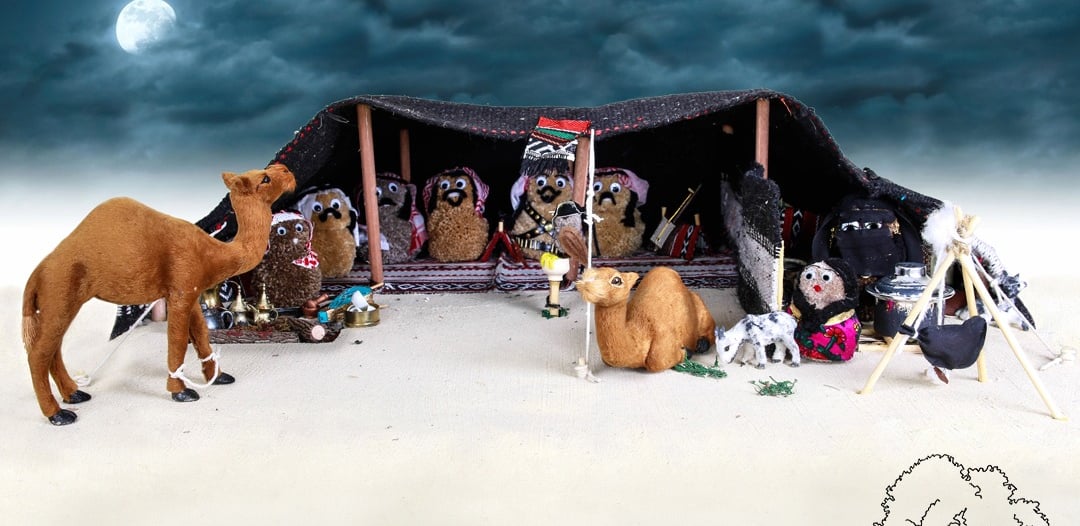

Hair Tents
Hair tents are among the most important tools Bedouins have built for themselves using technical and traditional methods. Hair tents are also distinguished by their resistance and ability to withstand the changing conditions of the desert environment. They are light and easy to move and maintain, and Bedouin women can repair hair tents without the need for assistance. The cover of the hair tent is made of sadu, which has small openings that allow air to pass through. In the summer, the hair strands swell and their loops constrict due to water. This prevents water from seeping into the tent. Furthermore, when a fire is lit inside the tent, the smoke rises through the openings in its ceiling.
Hair tents have partitions that divide them into two or more parts. The partition is called a qat'. The tent is rectangular in shape, open along one side (the front) and closed along the opposite side (the back). The back is only opened when necessary, such as when the wind direction changes or when seeking shade during intense heat.
The preferred type of house is one woven from goat hair. If goat hair is unavailable, sheep wool or camel hair can be used. This is because sheep wool or camel hair absorbs rainwater, causing it to drip and increase in weight, making it difficult to construct if it collapses.
Bedouin women, their daughters, and their female friends are responsible for weaving the house. The house consists of "shaqayq," one of which is pronounced "shaqqa," and the other is pronounced "shaka," or "faljan," and the other is called "falij."
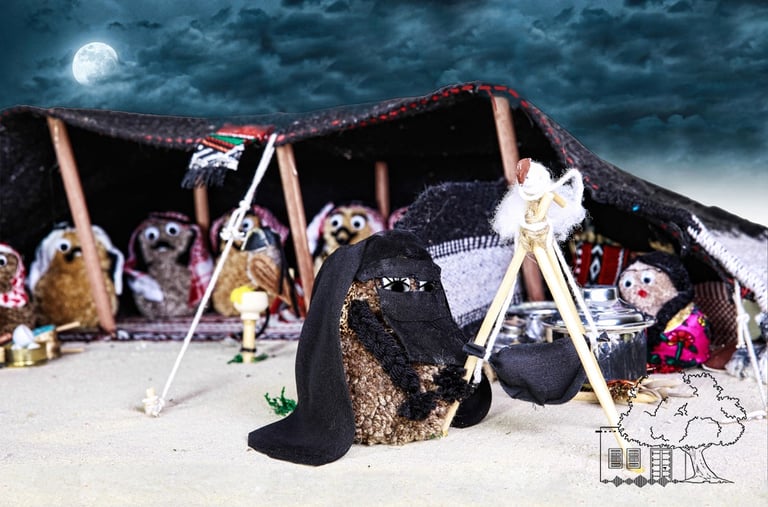

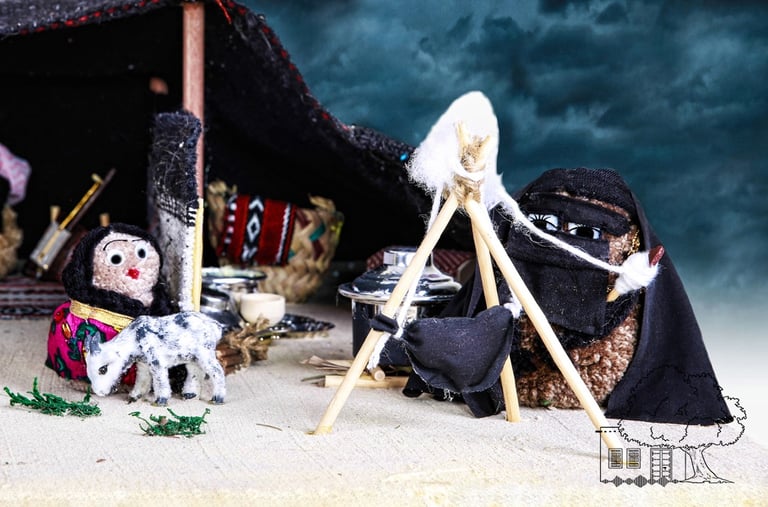

Al-Sadu (spinning, dyeing, drying, weaving)
Its names among the Bedouins, depending on the region and tribe:
((Al-Samil - Al-Sa'n - Al-Saqqa - Al-Qirbah - Al-'Akka))
Skins used in its manufacture:
Sheep hides are generally used to make Al-Sa'n, although small ones are preferred, while large ones are suitable. Method of making Al-Sa'n:
The sheep or animal's hide is skinned with precision, and the hide is cleaned of any remaining meat. Then, a special mixture of water, salt, and dates (roughly translated as "marees") is prepared. The hide is filled with this mixture, sealed tightly, tied, and buried in sand for a period of up to three days, or more or less. After that, the hide is removed, and the wool has begun to fall out. The wool is easily removed thanks to the previous mixture. The hide is emptied of its contents, dried, and then tanned. The tanning process consists of:
Arta + Karma Al-Athl + some Salm roots, which varies from one place to another. Each tribe has its own The method is to cook the above ingredients in a pot until boiling, then leave them to cool. The hide is then placed in the pot for a day or two until it absorbs the tanner's rind. It is then taken out and dried.
From this method, it is made:
The "samil" or "sa'n" (for milk or water)
The "qirba" or "badra" (for water). The "badra" differs in that it involves a process of stitching the hide and its handles from the trotters of the slaughtered animal.
The "saqqa" (water skin) is for milk and butter extraction.
The "akka" (butter skin) is for ghee.
Wool and Fur Weaving:
The wool and fur weaving process goes through the following stages:
Wool Shearing and Fur Collection:
Wool is sheared from sheep in the spring, and the fur is collected from camels in the summer.
Spinning:
This process usually takes place year-round and is performed using a spindle or a spindle.
Coloring:
After completing the spinning Wool and hair are dyed white in various colors. In the past, all of these colors came from desert plants.
Sadu or Weaving:
This last process is usually done in the summer because Bedouins are more sedentary during this season than in other seasons. Sadu is done using extended threads tied with four strings in a rectangular shape.
Weaving Uses:
The Bedouin use wool, hair, and goat hair fabrics in the following industries:
Bedouins use tents: Bedouins' dwellings in the desert, which they move wherever they travel.
Qati': A divider used to divide the tent into several spaces.
Riwaq: The awning of the tent, placed in the direction from which the wind blows.
Adul: Bags for storing food.
Mizawid: Bags smaller than Adul used for storing clothes.
Sanayef: Beautifully woven threads in bright colors used to decorate horses and camels.
Zawali: Rugs made of thick wool.
Basat: Tablecloths usually made of thick wool. With twisted threads.
Aql: These threads are used to tie the camels' legs while they are in their stables to prevent them from walking.
Sadu is considered one of the oldest traditional industries. It is considered one of the most important traditional crafts practiced in homes in ancient times, as it was considered the basic material used in furnishings, pillows, and blankets in homes in the past. It was also the basic material used to make tents and hair tents at that time.
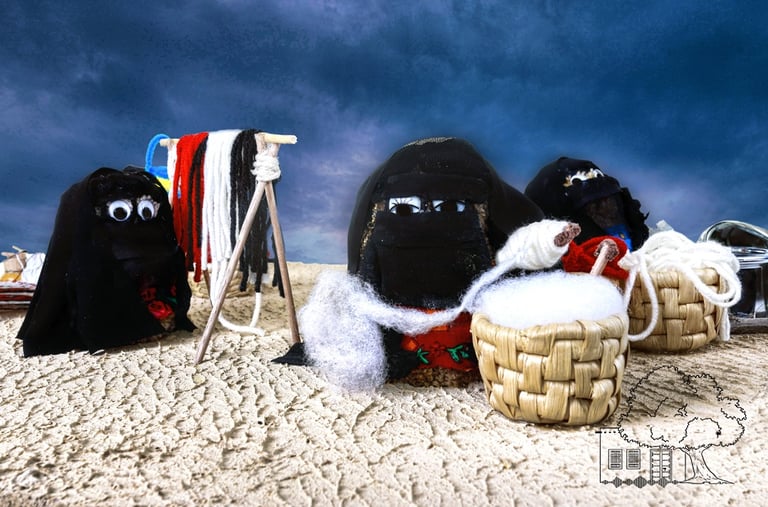

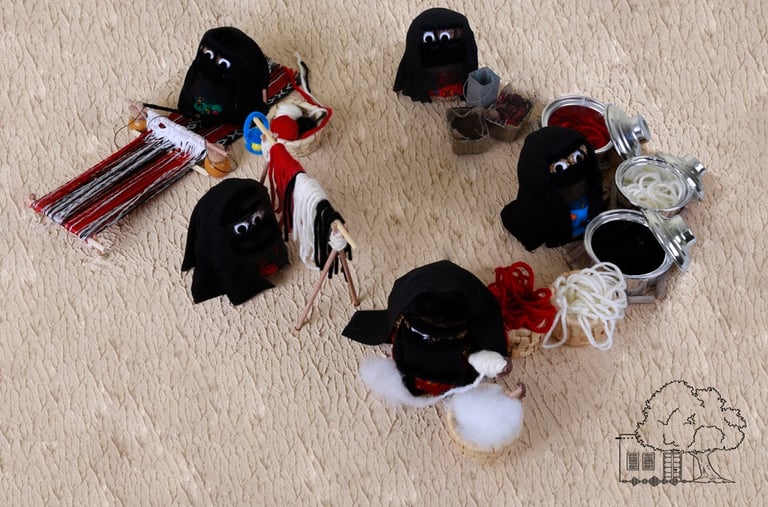

Coffee and Hospitality
The Bedouins know hospitality as an integral part of Bedouin life and a manifestation of their social life. Hospitality is known for its generosity, and it is attributed to them. It is well known that hospitality is a hallmark of Arab generosity, imposed on every individual, regardless of their wealth or possessions.
The Bedouin are extremely careful and committed to the conditions of hospitality, never neglecting its principles, regardless of the guest's status.
The guest is welcomed with the necessary respect and hospitality. He is slaughtered for them, and they are honored by serving coffee. One of their famous sayings is: "A guest is like a prince when he arrives, a prisoner when he stays, and a minister when he departs." They are welcomed like princes and consider themselves a prisoner of their host. They do not refuse any service offered to them. Upon their departure, they are not seen off in the same manner as they were welcomed, indicating their desire for a prolonged stay. The guest remains under the protection of their host and their tribe throughout their stay, unless they commit something dishonorable before the guest breaks the (malha). The word “malha” means food, meaning that someone is a guest of another man. In this case, the right of the first person ends and the right of the second person (the second host) begins, and so on.
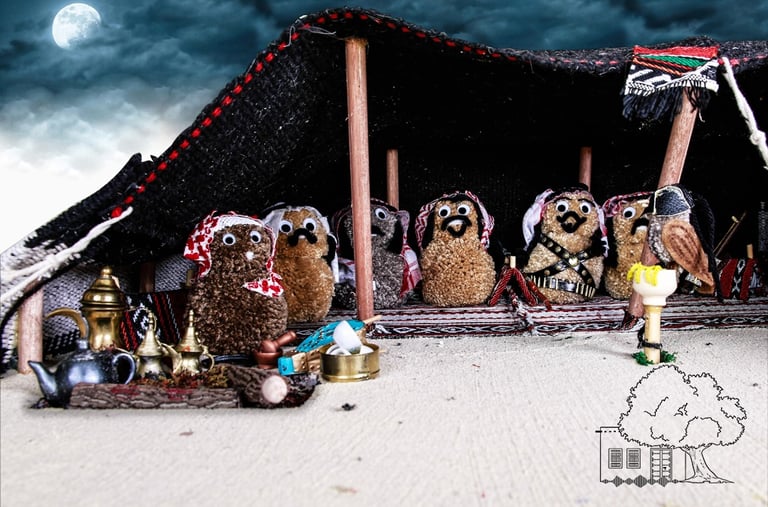

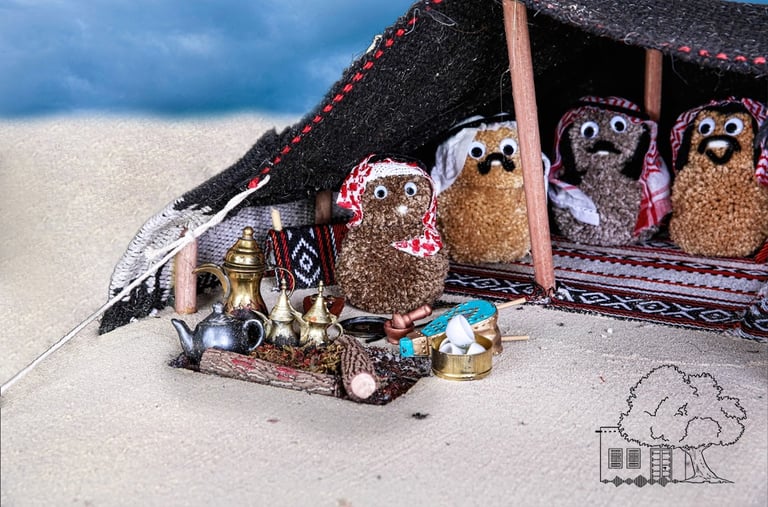

Ship Of The Desert (The Camel)
The Falcon
